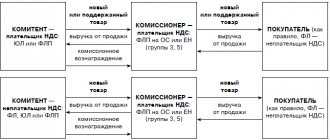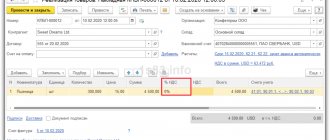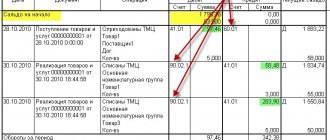Print (Ctrl+P)
Information for users about accounting for goods transferred for sale. Comprehensive automation 1.1
Head. buh. RAD asked the company to write this instruction for managers for the following reasons:
- Contracts with commission agents do not specify the type of selling prices, as a result of which operators are forced to adjust prices in documents. Perhaps the reason is due to the fact that no one is involved in pricing in the information base
- The delivery agreement with the commission agent is carried out as a whole, and not by transactions (orders), as a result of which it is impossible to track our sold and unsold goods in the stores of the commission agent. At first, I suggested creating one agreement with an agent for each store, but this is not entirely effective. However, then I realized that you can only enter into one contract for orders with an agent, and transactions within the scope of this single contract can be concluded with the store. It is enough to associate a transaction with a store using some identification characteristic, for example, Delivery address or another order property such as Store number.
Business transactions in management accounting of goods sold for sale
Business transactions in this section are as follows:
- Transfer for sale – Increases income and increases balances. The operation is registered by the document “Sales of goods and services”
- Return – reduces income (negative income is entered) and reduces balances. The operation is registered with the document “Return from the buyer”
- Selling increases expenses and reduces balances. The operation is registered with the document “Report of the commission agent on sales” upon presentation of an accompanying document from the commission agent, which is called “report to the commission agent on sales “
Important! Unfortunately, the “Write off of shipped goods at a loss” operation is not implemented in the comprehensive automation program. However, the commission agent may have another software product installed, for example, 1C: trade management, in this program the commission agent has the ability to draw up a report to the committent on the write-off for stolen goods. God is weak, the commission agent has not yet provided a report or act on written-off goods that cannot be returned or sold
Counterparty agreement
All business transactions with counterparties are formalized with the obligatory indication of the contract. In this section we will deal with the type of contract with a commission agent
It is very important for the user to understand the type of settlement :
- Conducting mutual settlements under the contract as a whole - A very simple, but very, very limited form of conducting mutual settlements with the commission agent and analytics of accounting for goods given on commission. As we will see below, I do not always recommend using this simple type of conducting mutual settlements. If this option for conducting mutual settlements is selected in the counterparty agreement, then analytics is carried out only for the agreement as a whole and mutual settlements are tracked for all documents drawn up under the agreement.
- Conducting mutual settlements for orders - The most recommended form of conducting mutual settlements with commission agents is my most recommended form. This is a more detailed option for conducting not only mutual settlements with the commission agent, but also for accounting for goods sold for sale. This option involves conducting mutual settlements within the framework of orders with the commission agent as a transaction. The complexity of this option lies in the fact that in all documents drawn up under such an agreement, indication of the order is mandatory.
- Conducting mutual settlements on accounts - this option is not practical for mutual settlements with a commission agent and I absolutely do not recommend it and I will not consider it . In this case, invoices for payment act as transactions.
Agreement for the sale of goods (sample 2019)
The buyer has the right not to pay for products of inadequate quality.
If delivery is made and the goods are not as described in the agreement, the buyer should take custody of the goods, notify the supplier in writing of the problem and collect payment for the provision of storage facilities. It is worth considering that civil law does not establish a strict term for the validity of the contract - the contract can be concluded for a certain period or without specifying a period. The contract may or may not outline a specific territory of execution; it may provide a list of goods that are the subject of the commission. When developing your sample contract for the sale of goods, you need to take these points into account.
- Interim measures may be applied to goods imported for specific orders. The argument that the measures will lead to the impossibility of selling the goods is rejected by the courts if, for example, the goods are not perishable (resolution of the 10th Arbitration Court of Appeal dated November 9, 2019 No. 10AP-13789/2019 in case No. A41-72633/15) .
- The buyer does not have the right to return the goods to the supplier if the sale does not take place. If the parties are interested in this right, this must be explicitly stated in the contract (resolution of the 17th Arbitration Court of Appeal dated May 16, 2019 No. 17AP-3169/2019-AKu in case No. A60-57555/2015).
- It is necessary to check the execution of documents for goods, in particular, regarding products subject to confirmation of conformity (serums, vaccines). Sales of products without indicating data on the declaration or certificate of conformity in the documentation entails liability under Art. 14.45 of the Code of the Russian Federation on Administrative Offences.
A supply agreement for the sale of goods - a sample of it can be useful for entrepreneurs operating by supplying goods, both as a one-time example for drawing up documentation, and for developing their own standard form of agreement.
A supply contract is an agreement concluded between a supplier and a buyer under certain conditions. The first undertakes to provide a batch of products, the second - to accept it properly and pay for it.
The legislator clearly defined the purpose of use - goods can only be used for business and not for personal needs. For example, in business activities (Art.
506 of the Civil Code of the Russian Federation), but not for home use.
For many entrepreneurs, it is much more profitable to enter into an agreement with suppliers for the supply of goods for sale. Under this agreement, one party agrees to provide certain products, and payment for them will be received only after the buyer is able to sell them.
As a rule, a supply agreement for the sale of goods (sample) is filled out by the parties without any questions asked.
If a misunderstanding arises between a supplier or a buyer, and, for example, the supplier cannot collect his money for a long time, it is logical that he will turn to lawyers.
Here he learns that this agreement is not a supply contract in its essence. The reason lies in non-compliance with essential conditions, namely, the determination of payment terms.
1. Product name;
2. Quantity of products.
Provide the Customer with the services specified in clause 1.2 of the Agreement.
2.1.2. Submit to the Customer for approval a list of employees involved in the implementation of the Contract.
2.1.3. Do not transfer or show to third parties the Customer’s documentation in the possession of the Contractor.
2.1.4. Cooperate in the provision of services under this Agreement with other contractors of the Customer.
2.1.5. Before the ___ day of each month, provide the Customer with monthly written reports on the progress of the provision of services under this Agreement.
2.1.6. Provide the Customer with materials and conclusions in electronic form on magnetic media, and, if necessary, written materials and conclusions.
2.1.7. Provide, if necessary, at the request of the Customer, explanations to interested parties, including government and judicial authorities, on the materials provided by the Contractor in accordance with this Agreement.
2.2.1. Provide the Contractor with premises equipped with workstations, office equipment, and communications equipment.
2.2.2. Provide the Contractor with documentation, information and reference programs and databases.
2.2.3. Pay for the Contractor's services in the manner, terms and conditions of this Agreement.
2.2.4. Provide the Contractor with information and materials necessary for the Contractor to fulfill its obligations under this Agreement.
2.2.5. Sign in a timely manner Certificates of provision of services by the Contractor.
2.3.1. Receive from the Customer any information necessary to fulfill its obligations under this Agreement. In case of failure to provide or incomplete or incorrect provision of information by the Customer, the Contractor has the right to suspend the performance of its obligations under this Agreement until the required information is provided.
2.3.2. Receive remuneration for the provision of services under this Agreement.
2.4.1. Receive services from the Contractor in accordance with clause 1.2 of this Agreement.
2.5. The provision of services not specified in the list of functions is formalized by an additional agreement of the Parties and is paid separately and additionally.
2.6. The Parties undertake to keep confidential commercial, financial and other confidential information received from the other Party during the execution of this Agreement.
3. PROCEDURE FOR EXECUTION OF THE AGREEMENT
3.1. The Contractor provides the Customer with monthly written reports on the progress of the provision of services under this Agreement, on the basis of which the Parties draw up and sign a Certificate of Provision of Services.
3.2. The Service Provision Certificates signed by the Parties are confirmation of the provision of services by the Contractor to the Customer.
3.3. Reports are provided by the Contractor by the ___ day of the month following the reporting month. The Service Provision Certificate is drawn up and signed by the Parties within ___ (______) business days from the date the report is provided.
3.4. When providing services not specified in the list of functions, the Contractor submits an additional report to the Customer and the Parties sign an additional Certificate of Provision of Services, which confirms the provision of additional services by the Contractor to the Customer.
4. PAYMENT PROCEDURE
4.1. The Contractor's remuneration is ______ (_________) rubles, including VAT in the amount of _____ (__________) rubles.
4.2. The remuneration is paid monthly before the ___ day of the current month.
4.3. The remuneration is paid by transferring the amount specified in clause 4.1 to the Contractor’s bank account.
4.4. The date of payment of funds is considered the day the funds are credited to the Contractor's current account.
5. RESPONSIBILITY OF THE PARTIES
5.1. For failure to fulfill or improper fulfillment of their obligations under this Agreement, the Parties bear other liability in accordance with the current legislation of the Russian Federation.
5.2. Neither Party will be liable for the complete or partial failure of the other Party to fulfill its obligations if the failure is a consequence of force majeure circumstances, such as fire, flood, earthquake, strikes and other natural disasters, war and hostilities, or other circumstances within our control. beyond the control of the Parties, preventing the implementation of this Agreement, arising after the conclusion of the Agreement.
If any of such circumstances directly affected the failure to fulfill the obligation within the period specified in the Agreement, then this period is proportionately extended for the duration of the relevant circumstance.
5.3. The Party for which it has become impossible to fulfill its obligations under the Agreement is obliged, no later than 5 days from the moment of their occurrence and termination, to notify the other Party in writing of the occurrence, expected duration and termination of the above circumstances.
6. PROCEDURE FOR CONSIDERATION OF DISPUTES
6.1. All disputes and disagreements that may arise between the Parties will be resolved through negotiations.
6.2. If controversial issues are not resolved during negotiations, the disputes are subject to consideration in the Arbitration Court of the city of ______________.
7. TERM OF THE AGREEMENT
7.1. The validity period of this Agreement is from “__”_______ ____ to “__”_________ _____.
7.2. This Agreement may be terminated by mutual agreement of the Parties.
7.3. If neither Party declares its desire to terminate this Agreement ___ (_________) days before the expiration date, this Agreement is considered extended for the next ________ on the same terms.
7.4. All changes and additions to this Agreement, as well as its termination, are considered valid provided that they are made in writing and signed by authorized representatives of both Parties.
8. OTHER TERMS
8.1. All additional agreements of the Parties, Acts and other Appendices to this Agreement, signed by the Parties when executing this Agreement, are an integral part of it.
8.2. This Agreement is drawn up in two copies having equal legal force, one for each of the Parties.
9. ADDRESSES AND DETAILS OF THE PARTIES
Customer: ________________________________________________________________________________________________________________________________________________________________________________________________
Performer: _____________________________________________________________________________________________________________________________________________________________________________________
SIGNATURES OF THE PARTIES
___________________________ ________________________
M.P. M.P.
- all announcements
- Services in Russia
- Trade cooperation
- Trading, sales of goods
Total 44 pages1234567Next {amp}gt;Last {amp}gt;{amp}gt;
Our company works with the largest online stores in Russia. We will take goods for sale or on consignment: men's women's children's clothing, leather goods (backpacks, bags for children/adults), accessories, toys, home textiles...
Objects of analytics of the movement of transferred goods in management accounting
The concept of “Movement” of transferred goods in management accounting means income and expense. They are accumulated in special registers, on the basis of which reports are generated. For example, in the accumulation register of transferred goods, income is determined by the shipment of goods minus returns, and expense is determined by goods sold; in accounting language this is called the debit and credit of account 45, respectively, and the balance of this account corresponds to the balance of unsold goods.
By the concept of an analytics object, I mean measurements in these accumulation registers, which are used to record the turnover and balances of transferred goods and payments. These measurements are:
- Nomenclature
- Counterparty
- Counterparty agreement
- Deal
- Transfer status
Please note that the Commission Agent's Store, where the goods are delivered, is not the object of accounting analytics, i.e. the program does not know which items remain unsold in the stores. This is only because the only agreement that is concluded with the commission agent is not based on orders and the committent does not want to create a separate agreement with each store.
Imagine, we need to track the goods sold in each store under one contract with an agent (commission agent). In this case, the contract must be concluded based on orders, since the delivery address is indicated in the order. It is the delivery address that connects the order with the store located at this address. However, it was also possible to maintain any store identification characteristic in the order properties, for example Store number. The main thing is that in all documents drawn up under such an agreement, indication of the order is mandatory.
Thus, the concept of an order means a transaction with a commission agent’s store, and by receiving analytics in the context of the order, we can track movements across stores.
Directory “Item Price Types”
The pricing section is not covered in this part of the instructions. We only note that the directory “Item Price Types” is intended to store only types of company selling prices.
The contract with the commission agent must indicate the type of selling prices below which the commission agent should not release goods to the final buyer.
Selling prices are used to default to transfer prices in shipping documents, agent orders, and agent sales reports. If there is no price type in the contract, operators are forced to adjust the prices in the shipping documents.
Selling prices are always assigned per unit of storage of item balances.
If the user is interested, I can add that all selling prices, in terms of methods of their formation and storage, are divided into three categories:
- "Base prices" . These prices are set for each item only manually. These prices are determined by the user and stored in the system. When accessing these prices, the system takes the most recent value. For these types of prices, in the Price calculation parameter it is indicated - “Prices are assigned and stored for each item of the item.”
- Estimated prices." Just like base prices, calculated prices are specified by the user and their value is stored in the system. The difference is that these prices have an automatic way of calculating them based on the base price data. That is, calculated prices are obtained from the base prices through some procedure, for example, by increasing the base price values by a certain markup percentage. Regardless of how the calculated price is ultimately obtained, the system stores only the resulting price value itself and the type of base prices on the basis of which the calculation was made. Estimated prices can be wholesale and retail prices obtained on the basis of factory prices or based on the planned cost of production. For these prices, the “Price calculation” parameter indicates “Prices are assigned and stored for each product item”, and also sets the value of the base price and markup.
- Dynamic prices" . The values of these prices are not stored in the system; only the method for calculating them is stored. These prices, like calculated prices, are obtained from base prices using special mechanisms. However, the calculation results are not stored in the system; the calculation is performed directly at the time of accessing these prices. For these prices, the “Price calculation” parameter indicates “Prices are calculated automatically from prices of the base type”, and also sets the value of the base price and markup.
This allows you to use prices if selling prices are strictly linked to the base price, which changes quite often.
It is possible to store prices that include value added tax (VAT). For this purpose, the dialog provides a flag “ Prices include VAT” .
Postings in the accounting of goods sold for sale
Let's consider the procedure for reflecting in the accounting records of the principal the operations of the sale of goods under a commission agreement with the participation of the commission agent in the calculations. The wiring diagram in question reflects the following order of events:
The seller (consignee) ships the goods (to the commission agent). The intermediary sells the goods to the buyer. The buyer makes payments for the goods received with the intermediary (commission agent). Next, the intermediary reports to the seller (committee) on the sales results, determines the amount of the commission and transfers the funds received for the goods sold, minus the commission. Funds may be transferred to the principal in full (determined by the terms of the commission agreement). In this case, the seller (committee), based on the provided invoices and certificates of completion of work, pays a commission to the intermediary (commission agent) separately.
| Account Dt | Kt account | Wiring Description | Transaction amount | A document base |
| 45 | 41 | We reflect the shipment of goods to the commission agent for further sale | Cost of goods | Consignment note according to form No. TORG-12 |
| 76.05 | 90.1 | We reflect the sale of goods based on the commission agent’s report (copies or copies of invoices must be attached to the report) | Revenue from sales of goods | Commissioner's sales report |
| Invoice | ||||
| 90.2 | 45 | We write off the cost of goods sold | The amount of the cost of goods (determined by the method of writing off material assets) | Commissioner's sales report |
| Invoice | ||||
| 90.3 | 68.2 | We charge VAT related to goods sold | VAT amount | Commissioner's sales report |
| Invoice | ||||
| 44 | 76.05 | We reflect the commission agent's reimbursable expenses based on the commission agent's report (with attached documents confirming the expenses incurred) | Amount of expenses | Commissioner's sales report |
| Invoice | ||||
| 19 | 76.05 | We reflect VAT related to the reimbursable expenses of the commission agent | VAT amount on expenses | Commissioner's sales report |
| Invoice | ||||
| 44 | 60.01 | We reflect commission remuneration on the basis of acts and accounts of the commission agent | Commission amount | Certificate of completion |
| 19 | 60.01 | We reflect VAT related to commission fees | VAT amount on commission | Certificate of completion |
Value added tax (VAT)
The sale of property rights on the territory of the Russian Federation is subject to VAT (clause 1, clause 1, article 146 of the Tax Code of the Russian Federation).








